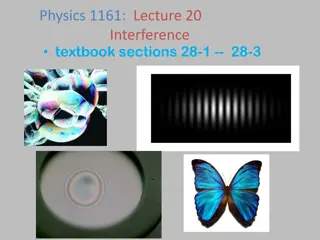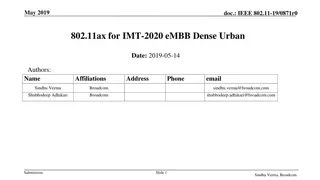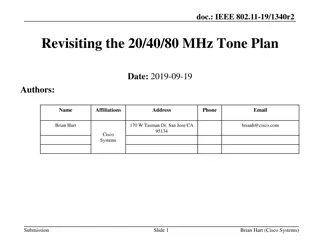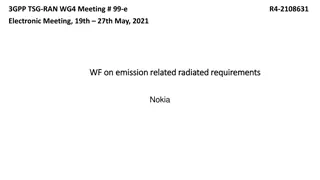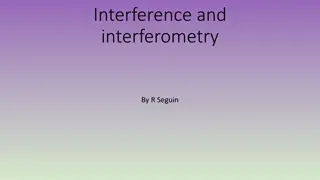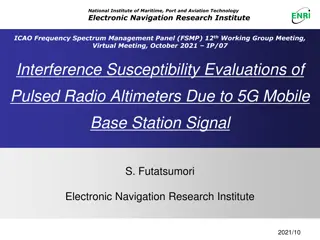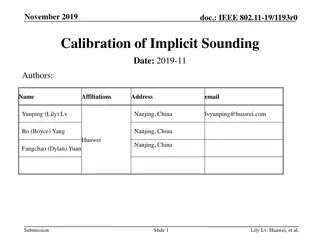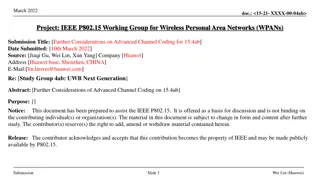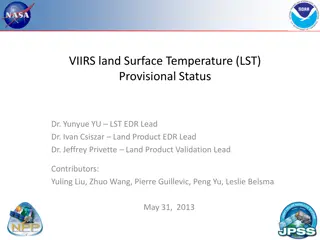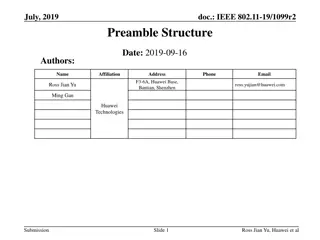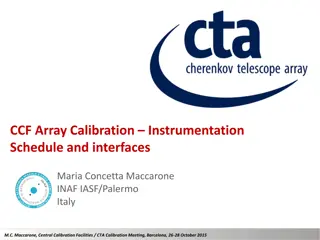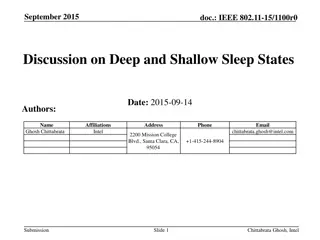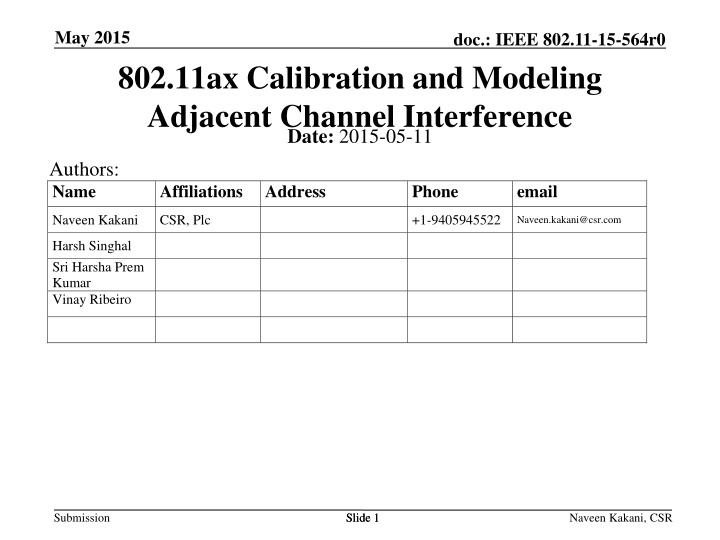
IEEE 802.11ax Calibration and Modeling Adjacent Channel Interference
Explore the calibration results and performance metrics for IEEE 802.11ax in various scenarios such as residential, enterprise, and indoor small BSS. The document delves into adjacent channel interference and provides insights into mitigating interference in different frequency bands. Dive into the complexities of interference modeling and performance evaluation in wireless communication systems.
Download Presentation

Please find below an Image/Link to download the presentation.
The content on the website is provided AS IS for your information and personal use only. It may not be sold, licensed, or shared on other websites without obtaining consent from the author. If you encounter any issues during the download, it is possible that the publisher has removed the file from their server.
You are allowed to download the files provided on this website for personal or commercial use, subject to the condition that they are used lawfully. All files are the property of their respective owners.
The content on the website is provided AS IS for your information and personal use only. It may not be sold, licensed, or shared on other websites without obtaining consent from the author.
E N D
Presentation Transcript
May 2015 doc.: IEEE 802.11-15-564r0 802.11ax Calibration and Modeling Adjacent Channel Interference Date: 2015-05-11 Authors: Name Affiliations Address Phone email Naveen Kakani CSR, Plc +1-9405945522 Naveen.kakani@csr.com Harsh Singhal Sri Harsha Prem Kumar Vinay Ribeiro Submission Slide 1 Slide 1 Naveen Kakani, CSR
May 2015 doc.: IEEE 802.11-15-564r0 Abstract Box 1 Calibration results for all Simulation of Scenarios (Reference: 11-14-0800-29-00ax-box-1-and- box-2-calibration-results.xlsx) Adjacent Channel interference modeling and performance numbers Submission Slide 2 Slide 2 Naveen Kakani, CSR
May 2015 doc.: IEEE 802.11-15-564r0 Residential Scenario (SS1) Submission Slide 3
May 2015 doc.: IEEE 802.11-15-564r0 Enterprise Scenario (SS2) 100 Huawei 90 BRCM 80 LG 70 MRVL Intel 60 CDF (%) MTK 50 Ericsson 40 ZTE 30 20 10 0 30 40 50 60 70 80 Test 1 - Interference free DL SNR (dB) Submission Slide 4
May 2015 doc.: IEEE 802.11-15-564r0 Indoor Small BSS (SS3) 100 Huawei 90 BRCM 80 LG 70 MRVL 60 CDF (%) Nokia 50 Intel 40 MTK 30 20 10 0 30 40 50 60 70 80 Test 1 - Interference free DL SNR (dB) Submission Slide 5
May 2015 doc.: IEEE 802.11-15-564r0 Adjacent Channel Interference - 20MHz Interferer: - Noise Power (2.4GHz Band) = Tx Power + Path Loss 23.77dB - Noise Power (5GHz Band) = Tx Power + Path Loss 23.72dB - 40MHz Interferer: 2.4GHz Band 5GHz Band Noise Power in first adjacent 20MHz Channel = Tx Power + Path Loss 25.02dB Noise Power in first adjacent 20MHz Channel = Tx Power + Path Loss 25.02dB Noise Power in the second adjacent 20MHz Channel = Tx Power + Path Loss 36.99dB Noise Power in the second adjacent 20MHz Channel = Tx Power + Path Loss 35.61dB Noise Power in the 40MHz Adjacent Channel: TX Power of Interferer + Path Loss 24.75dB Noise Power in the 40MHz Adjacent Channel: TX Power of Interferer + Path Loss 24.65dB If the 40MHz BSS is interfering with an 80MHz BSS (40MHz operation is on the center 40MHz of the 80MHz BSS), then the adjacent Channel power on the 80MHz BSS is: TX Power of the Interferer + Path Loss 25.02dB + 3dB If the 40MHz BSS is interfering with an 80MHz BSS (40MHz operation is on the center 40MHz of the 80MHz BSS), then the adjacent Channel power on the 80MHz BSS is: TX Power of the Interferer + Path Loss 25.02dB + 3dB Submission Slide 6
May 2015 doc.: IEEE 802.11-15-564r0 Adjacent Channel Interference 80MHz Interferer: Noise Power in adjacent Channels - Noise Power in first adjacent 20MHz Channel = Tx Power + Path Loss 26.88dB - Noise Power in second adjacent 20MHz Channel = Tx Power + Path Loss 31.79dB - Noise Power in third adjacent 20MHz Channel = Tx Power + Path Loss 36.73dB - Noise Power in fourth adjacent 20MHz Channel = Tx Power + Path Loss 43.01dB - Noise Power in first adjacent 40MHz Channel (40-80) = Tx Power + Path Loss 25.67dB - Noise Power in second adjacent 40MHz Channel (60-100)= Tx Power + Path Loss 30.58dB - Noise Power in third adjacent 40MHz Channel (80-120)= Tx Power + Path Loss 35.81dB - Noise Power in adjacent 80MHz Channel (40-120)= Tx Power + Path Loss 25.27dB - Noise Power in adjacent 60MHz Channel (40-100)= Tx Power + Path Loss 25.34dB (there is a common channel for both the BSS s) - Noise Power in adjacent 60MHz Channel (60-120)= Tx Power + Path Loss 30.34dB Submission Slide 7
May 2015 doc.: IEEE 802.11-15-564r0 Simulation Setup to test impact of Adjacent Channel Interference The simulation setup for testing the model is as follows - n2 | AP1 -- n1 n3 | AP2 | n4 Continuous downlink traffic from each AP to its stations Continuous uplink traffic from n1 and n3 to AP1 and AP2 respectively STA n1 is between AP1 and AP2 MCS5 used on all links, no support for TXOP and A-MPDU Simulation run for 10 sec Data rate of application limited to 10 Mbps i.e., offered load in each BSS is 30Mbps With Adjacent Channel interference: - There will be drop in Throughput at AP2 and AP2 will sense the medium to be busy and will not transmit enough data to STA n3, n4 - There will be drop in Throughput at STA n1, and at AP1 because STA n1 will sense the medium to be busy and will not transmit uplink data to AP1 Submission Slide 8
May 2015 doc.: IEEE 802.11-15-564r0 Test Cases Results Distance between station and AP = 20m Distance between AP1 and AP2 = 40m Test Case 3: Test Case 2: Test Case 1: BSS1 20 MHz, in channel 1 BSS1 20 MHz, in channel 6 BSS1 20 MHz, in channel 1 BSS2 40 MHz, in channel 6,11 BSS2 20 MHz, in channel 11 BSS2 20 MHz, in channel 11 throughput at n1 = 6.944 throughput at n1 = 7.1864 throughput at n1 = 5.5776 throughput at n2 = 3.8376 throughput at n2 = 4.088 throughput at n2 = 2.8552 throughput at AP1 = 6.3224 throughput at AP1 = 5.6568 throughput at AP1 = 8.5912 throughput at n3 = 6.2448 throughput at n3 = 4.5584 throughput at n3 = 5.7856 throughput at n4 = 3.788 throughput at n4 = 2.32 throughput at n4 = 2.9576 throughput at AP2 = 9.9816 throughput at AP2 = 9.9728 throughput at AP2 = 8.5216 Aggregate throughput at BSS1 = 17.104 Aggregate throughput at BSS1 = 16.9312 Aggregate throughput at BSS1 = 17.024 Aggregate throughput at BSS2 = 20.0144 Aggregate throughput at BSS2 = 16.8512 Aggregate throughput at BSS2 = 17.2648 Net throughput = 0.61864 Mbps/MHz Net throughput = 0.84456 Mbps/MHz Net throughput = 0.85722 Mbps/MHz - Drop is throughout at AP1 in Test case 2 because STA n1 is not transmitting enough (Energy Detect Adjacent Channel interference), similarly there is drop in Throughput at STA4 and STA3 because AP2 is transmitting enough - Not a significant drop in BSS throughput with and with out Adjacent Channel Interference, but individual STAs have an impact on their throughput Submission
May 2015 doc.: IEEE 802.11-15-564r0 Test Cases Results Distance between station and AP = 10m Distance between AP1 and AP2 = 20m Test Case 2: BSS1 20 MHz, in channel 6 BSS2 20 MHz, in channel 11 throughput at n1 = 5.0104 throughput at n2 = 2.3824 throughput at AP1 = 4.6472 throughput at n3 = 3.7992 throughput at n4 = 1.768 throughput at AP2 = 6.6688 Aggregate throughput at BSS1 = 12.04 Aggregate throughput at BSS2 = 12.236 Net throughput = 0.6069 Mbps/MHz Test Case 1: BSS1 20 MHz, in channel 1 BSS2 20 MHz, in channel 11 throughput at n1 = 5.6176 throughput at n2 = 2.904 throughput at AP1 = 8.6472 throughput at n3 = 5.7184 throughput at n4 = 2.9056 throughput at AP2 = 8.488 Aggregate throughput at BSS1 = 17.1688 Aggregate throughput at BSS2 = 17.112 Net throughput = 0.85702 Mbps/MHz Test Case 3: BSS1 20 MHz, in channel 1 BSS2 40 MHz, in channel 6,11 throughput at n1 = 6.1328 throughput at n2 = 3.0664 throughput at AP1 = 4.8888 throughput at n3 = 4.0672 throughput at n4 = 2.0528 throughput at AP2 = 7.4448 Aggregate throughput at BSS1 = 14.088 Aggregate throughput at BSS2 = 13.5648 Net throughput = 0.46088 Mbps/MHz - No difference in Test case 1 results when compared to the scenario where the distance between AP and STA is 20m From test case 1 to Test case 2 and Test case 3, significant drop in Net Throughput with Adjacent Channel interference (this can be residential scenario with a wall between two apartments) - Submission
May 2015 doc.: IEEE 802.11-15-564r0 Test Cases Results Distance between station and AP = 10m Distance between AP1 and AP2 = 10m Test Case 1: BSS1 20 MHz, in channel 1 BSS2 20 MHz, in channel 11 throughput at n1 = 5.6256 throughput at n2 = 2.896 throughput at AP1 = 8.648 throughput at n3 = 5.7128 throughput at n4 = 2.9 throughput at AP2 = 8.4856 Aggregate throughput at BSS1 = 17.1696 Aggregate throughput at BSS2 = 17.0984 Net throughput = 0.8567 Mbps/MHz Test Case 3: BSS1 20 MHz, in channel 1 BSS2 40 MHz, in channel 6,11 throughput at n1 = 3.9328 throughput at n2 = 1.8688 throughput at AP1 = 6.1384 throughput at n3 = 3.74 throughput at n4 = 1.9512 throughput at AP2 = 4.8536 Aggregate throughput at BSS1 = 11.94 Aggregate throughput at BSS2 = 10.5448 Net throughput = 0.374747 Mbps/MHz Test Case 2: BSS1 20 MHz, in channel 6 BSS2 20 MHz, in channel 11 throughput at n1 = 4.0832 throughput at n2 = 1.2792 throughput at AP1 = 5.624 throughput at n3 = 3.0736 throughput at n4 = 1.528 throughput at AP2 = 4.3744 Aggregate throughput at BSS1 = 10.9864 Aggregate throughput at BSS2 = 8.976 Net throughput = 0.49906 Mbps/MHz - No difference in Test case 1 results when compared to the scenario where the distance between AP and AP is 40m or 20m Test case 2 and 3 show significant degradation on the same lines when the distance between the AP s is around 20m - Submission
May 2015 doc.: IEEE 802.11-15-564r0 Conclusions Adjacent Channel interference alone shows degradation in BSS throughput Recommend to include Adjacent Channel Interference Modeling in Simulation Scenarios Submission Slide 12



